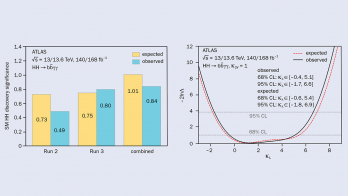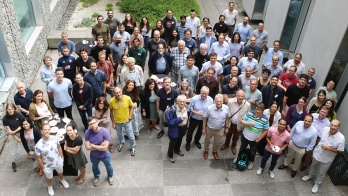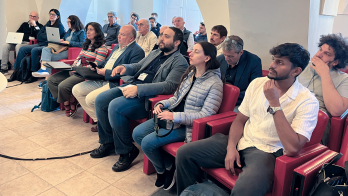The Standard Model of particle physics has been extremely successful in predicting a vast variety of phenomena – so successful, that it is easy to forget that some of its predictions have not yet been verified. A very important one, related intimately to electroweak symmetry breaking, is that the gauge bosons (γ, W and Z) can interact with each other through quartic interactions. Four such interactions are allowed in the Standard Model: WWWW, WWZZ, WWZγ and WWγγ. The other boson combinations are forbidden on symmetry grounds. Now the ATLAS collaboration has found evidence for a process involving the first of these three – the WWWW interaction.

The WWWW and WWZZ interactions, in particular, are of great theoretical interest. If there were no Higgs boson, the rate of these processes would become unphysically large. With the discovery of a Higgs boson, they have remained interesting as a way to study electroweak symmetry breaking and even to probe for new heavier Higgs bosons. At the LHC, the WWWW interactions can be studied through the radiation of W bosons from quarks (see figure). This is a rare process, making the interaction of W bosons particularly rare and difficult to detect.
The ATLAS collaboration has presented the first evidence of this rare process involving a quartic WWWW interaction in a paper submitted to Physical Review Letters. The ATLAS analysis selected events with two same-charge W bosons (reconstructed through their leptonic decays to electron or muon and their respective (anti)neutrinos) and two jets. The background from other Standard Model processes is reduced by using the fact that these processes rarely produce two leptons with the same electric charge, together with the knowledge that the quarks that recoil off the radiated W bosons will produce jets that are separated widely and have a particularly large invariant mass.
Data collected by the ATLAS experiment show an excess of these events across the predicted background, with a statistical significance of 3.6σ. The measured fiducial cross-section is 1.3±0.4 fb, in agreement with the Standard Model expectation of 0.95±0.06 fb, and provides the first step into a previously untouched segment of the Standard Model.
Further reading
ATLAS Collaboration 2014 submitted to Phys. Rev. Lett. arXiv:1405.6241.








